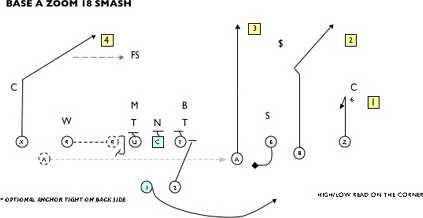It’s either the bastardization of the game or the next logical step in its progression.
A travesty, an abomination, or the best thing in football since the forward pass.
Innovative or just plain sneaky.
The only thing about the A-11 offense that’s universally agreed upon is that it’s causing a stir.
First things, first: The A-11, which takes its name from the idea that all 11 offensive players can be elgible to receive a pass, first popped up in northern California in 2007. It takes advantage of a rule known as the "scrimmage kick exception," which exempts interior linemen from wearing jerseys numbered 50-79 when a player receiving the snap is at least seven yards behind the line of scrimmage.
Eligible receivers are required to wear Nos. 0-49 or 80-99.
The rule was originally meant to allow a back or receiver to double as the team’s deep snapper. But after the 2006 season, Piedmont High School (Calif.) coaches Kurt Bryan and Steve Humphries cooked up a scheme that used the rule in a way no one previously had.
Football rules mandate that seven players must be on the line of scrimmage when the ball is snapped, and only five are eligible receivers (the players on the ends of the line of scrimmage and the three behind the line).
In a traditional offense, whether it’s the wishbone or the shotgun spread, that means five linemen and couple of split ends or tight ends or a combination of the two.
In the base A-11 formation, there are three interior linemen, two potential quarterbacks and everybody else lines up wide. Then the fun (or the aggravation) begins.
Often, players in the A-11 don’t take their spots until seconds before the ball is snapped. Until they do, any player on the field could be an elgible receiver, leaving the defense with no way of knowing who’s going to run pass routes and who’s going to block.
According to a Scientific American study, the number of possible formations increases from 36 to a mind-boggling 16,632 when A-11 concepts are introduced.
"It would be a headache to try to stop," Gainesville coach Bruce Miller said.
Thanks to a recent rule change by the National Federation of State High School Associations, he may not have to worry about it.
The National Federation, a rule-setting organization which is recognized in 48 states (including Georgia) and the District of Columbia, moved to close the loophole last week by requiring four players on the line with numbers 50-79 on first, second and third downs. Centers may wear any number, but are automatically ineligible.
But Bryan, Piedmont’s head coach, said his high-flying offense won’t stay down. He’s preparing to release a petition next week to get the offense back in play. He won’t discuss many specifics, but he’s confident the National Federation will feel compelled to see things his way.
"We’re extending a massive olive branch to the (National) Federation and to each state association," Bryan said.
And if they don’t accept it?
"Well, then there’s what you could call the nuclear option," Bryan said. "I don’t want to say anything more than that right now."
What that means is anybody’s guess until the petition is released next Thursday.
Same goes for the future of the A-11 and for the future of football if it’s allowed to stick around.
It has spread to more than 1,000 high schools in the last two years, Bryan estimates. He’s got game officials in his corner who say the offense isn’t too complicated to referee, and he’s got legions of curious coaches picking his brain (including the staff of a major Pac-10 university, Bryan said).
In the opposing corner stand the status quo, an equally large contingent of coaches and now a widely recognized rule book.
Humphries, who’s also Piedmont’s director of football operations, said none of that will deter he and Bryan. He thinks the new rule will be overturned. If not, he hinted that they’ve got more up their sleeves.
"There’s nothing they can do on this one," Humphries said, alluding to concepts and schemes that he plans to unveil next season. "Short of saying ‘you have to pack in five guys close to the ball on the line of scrimmage,’ there’s nothing the rules committee will be able to say."
In one form or an unspecified other, it seems change is coming. It always does.
Whether or not it’s ushered in by the A-11 or one of its derivatives, only time will tell. But it’s been more than 130 years since Walter Camp threw the first forward pass (illegally), and it’s about time for another shakeup.
Stay tuned.
Brent Holloway is the sports editor of The Times. His column appears each Friday.

